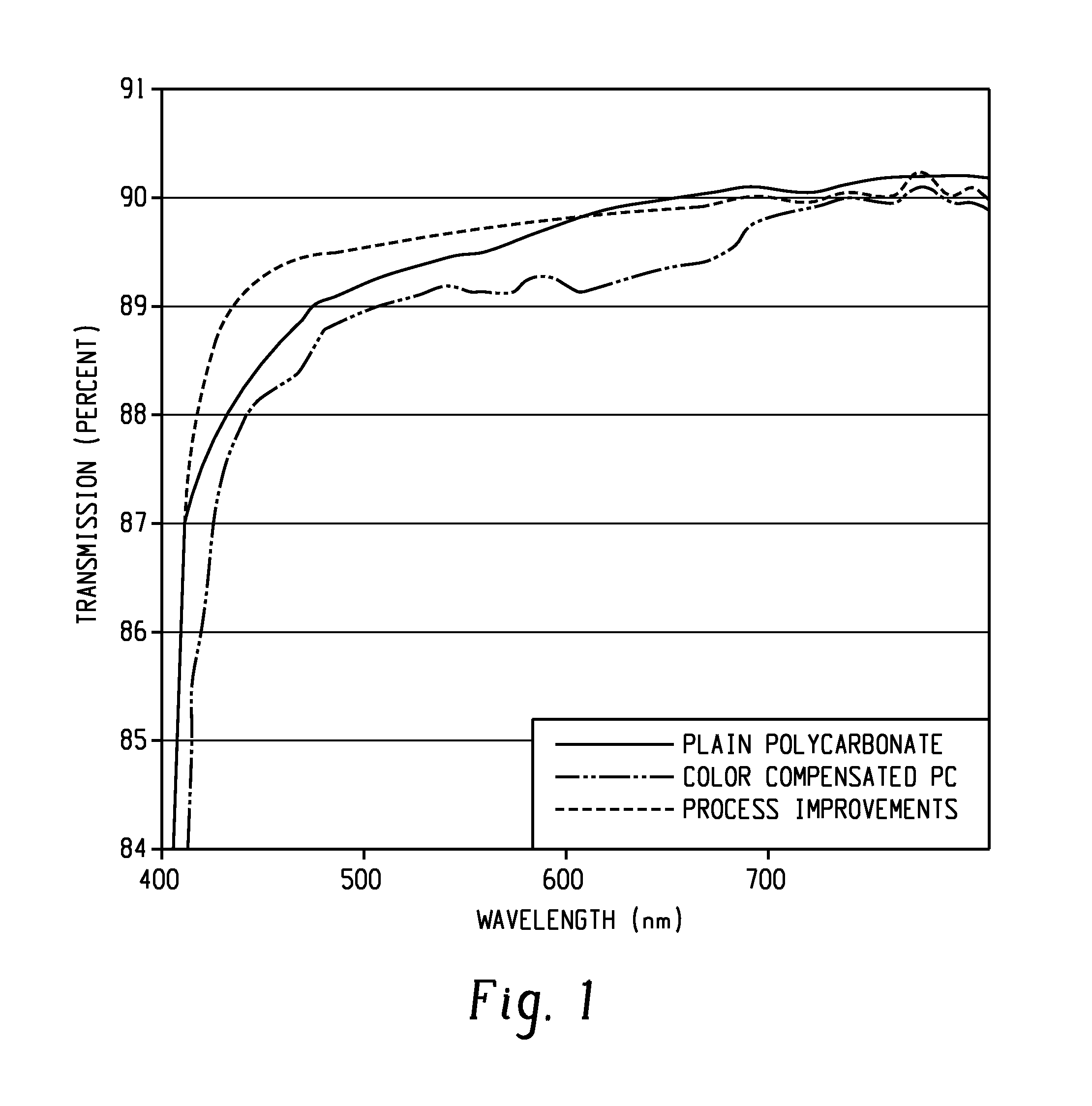Processes for preparing polycarbonates with enhanced optical properties
a technology of optical properties and polycarbonates, applied in the field of polycarbonate resins and processes for preparing polycarbonate resins, can solve the problems of reducing light transmission and color changes, and achieve the effects of low yellowness, high light transmission and color stability
- Summary
- Abstract
- Description
- Claims
- Application Information
AI Technical Summary
Benefits of technology
Problems solved by technology
Method used
Image
Examples
example 1
[0103]Two polycarbonates were made, one using high purity polycarbonate and one using lower grade regular polycarbonate. The two polycarbonates were made to meet the same color specification (b-value) by the addition of two blue dyes (R72—Solvent Violet 36 and R7260—Pigment Blue 60) during extrusion. The L* and color feeder set points were then compared to each other.
[0104]The high purity polycarbonate had a starting yellowness index of about 1.0, while the regular polycarbonate had a starting yellowness index of about 1.2 (according to ASTM D6290). The resulting setpoints for each blue dye are shown below in Table 2.
TABLE 2R72 setpointR7260 setpointRegular polycarbonate0.1540.111High purity polycarbonate0.1000.085% reduction35%23.40%
[0105]As can be seen in Table 2, the use of the high purity polycarbonate resulted in a significant decrease in the amount of colorant needed to meet color specifications.
[0106]FIG. 2 is a comparison of the L* for the high purity polycarbonate (measured...
example 2
[0107]A polycarbonate was made to illustrate the optimization processes of the present disclosure. The acceptable melt flow value for this polycarbonate was between 6.2 to 8.7 g / 10 min. As to color, the target and lower specification limit (LSL) are shown in Table 3.
TABLE 3TargetLSLL*95.1094.70a*−0.21−0.36b*0.330.20
[0108]A higher L* can be beneficial (i.e. closer to 100), and a lower b* can be beneficial (i.e. closer to zero or negative). In this regard, natural colors are neither strongly yellow nor strongly blue in a molded article.
[0109]Table 4 shows the process of optimization here. The color feeder setpoint, melt flow rate (MFR), feed rate to the extruder, and the torque are shown, along with the resulting color space values. The MFR was measured according to ASTM D1238. The color feeder is shown in units of % of the master line rate (the line rate is measured in lbs / hr). The feed rate is shown in units of lbs / hour.
TABLE 4ColorFeed RateTorqueStageL*a*b*feederMFR(lbs / hr)(%)194.4...
PUM
| Property | Measurement | Unit |
|---|---|---|
| conductivity | aaaaa | aaaaa |
| pore size | aaaaa | aaaaa |
| pore size | aaaaa | aaaaa |
Abstract
Description
Claims
Application Information
 Login to View More
Login to View More - R&D
- Intellectual Property
- Life Sciences
- Materials
- Tech Scout
- Unparalleled Data Quality
- Higher Quality Content
- 60% Fewer Hallucinations
Browse by: Latest US Patents, China's latest patents, Technical Efficacy Thesaurus, Application Domain, Technology Topic, Popular Technical Reports.
© 2025 PatSnap. All rights reserved.Legal|Privacy policy|Modern Slavery Act Transparency Statement|Sitemap|About US| Contact US: help@patsnap.com



